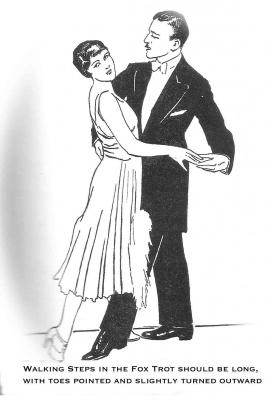- Historical Dance
- Jazz Age Social Dancing ("The Modern Dances")
- 0. The Essentials of Jazz Age Ballroom Dancing
- 1. Foxtrot Part 1: The Jazz Age Foxtrot
- 2. Youth Dancing in the Jazz Age
- 3. The Jazz Age Waltz
- 4. The Jazz Age Tango
- 5. 1930s Rumba
- 6. 1930s Samba
- 7. 1930s Conga
- 8. Bal Musette: Parisian Dance of the Jazz Age
- 9. Dancing in Weimar Berlin
- Dancing Made Easy - 1922
- Film Library - Jazz Age Dance
- Historical Dance Films posted to Pinterest
- Jazz Age Dance - Apologia
- Jazz Age Dance Image Collection
- Jazz Age Lead and Follow
- Places to Dance in Southern California in the Jazz Age
- Sampler of Jazz Age Dance Holds
- The Pathé Historical Dance Collection: 1920s-40s
- Ragtime Dance - the One Step
- Regency Dance
- Victorian Dance
- Jazz Age Social Dancing ("The Modern Dances")
1. Foxtrot Part 1: The Jazz Age Foxtrot
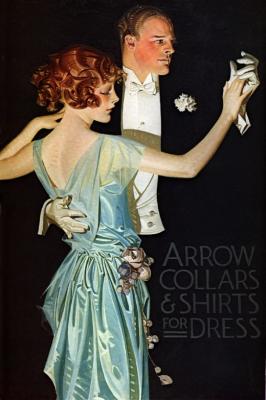 If you think Foxtrot is difficult, you're probably doing it wrong
If you think Foxtrot is difficult, you're probably doing it wrong
The Foxtrot (or "Fox Trot", "Fox-Trot" or just "Fox") was, hands down, the most popular dance of the 1920s and 1930s - and it was also the easiest. The essential step was nothing more than smooth, graceful walking. The dancers had the option of introducing more elaborate step patterns, but all rested on a foundation of walking. Its simplicity and infinite variability meant that it could be adapted to almost any dance situation.
Jazz at the time was generally classified as either "Sweet" or "Hot". The Sweet Jazz had a moderate to slow tempo, and a smooth, mellow sound. The Hot Jazz was moderate to fast tempo with a brash, bouncy, jazzy feel. Sweet Jazz made you want to glide and sway. Hot Jazz made you want to shake, shimmy, kick and spin. Within these categories, each piece had its own spirit, and the measure of a good dancer was the ability to match the dance to the music.
To dance to the Sweet Jazz, one would use the smooth, flowing style sometimes called the "Slow Foxtrot" or "Slow Fox" or just "Fox Trot". When the hot jazz kicked in, you might still call the dance a "Fox Trot" or if you might call it a "One Step" or (in Britain) "Quick Step". The dancers and composers of the time never reached a consensus on what to call things and the term "Fox Trot" was tossed about indiscriminately to describe any dance in 4/4 time, including, by the late '30s, Swing - though the over-thirty crowd invariably Foxtrotted to that new-fangled Swing music. This continued into the '50s. Bill Haley and the Comets' "Rock Around the Clock" is identified on its original record label, as a "Fox Trot With Vocals". The dancers of the time worked on the "when in doubt, Foxtrot" philosophy, and there are videos in this collection of dancers Foxtrotting to a Rumba and a Polka, as well as Swing.
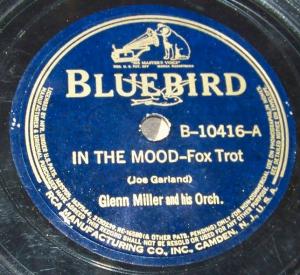 Foxtrot is everything, and everything is Foxtrot.
Foxtrot is everything, and everything is Foxtrot.
If your idea of the Foxtrot requires steps done in "Slow-Slow-Quick-Quick", or some other combination of "Slows" and "Quicks", I would suggest clearing your mind of such things for the moment. If that's how you like to Foxtrot, the free and easy nature of the Jazz Age gives you absolute permission to dance that way, and there are numerous examples of Slow-Quick step combinations from the era, but such steps are optional and not an essential element of the Foxtrot.
The essential pattern is thus: walk for a while (either straight or with your favorite step pattern), then do a "variation" involving side steps, turning, reversing (man backing) or some other combination that is graceful and physically possible; and then walk some more until the next variation. Keep moving (traffic permitting) in line of direction (counter clockwise around the floor) and don't let your partner out of the embrace. Variations are optional and variable. No particular variation is essential to the act of Foxtrotting. If a step pattern that's more complex than walking works better for you, do that instead. If a dance made up of the most basic steps feels right for you and your partner, then stick with that.
Variations can be improvised or practiced and choreographed, depending on the proclivities of the dancers. The follower should not worry too much about exactly what her feet are doing, but relax and put them where they seem to need to go. That should suffice for most variations, given the restrained and contained nature of the dance; and if it doesn't, then the partners will need to have worked out the details before hand or the leader will need to be less inscrutable in his leading.
If the floor is crowded, as so often it was at the time, you can have a very satisfactory dance in a very small space, just taking short back and forth, turning and side to side steps in the space available, while focusing on the rhythm and the sense of flow. This dance, while it can travel great distances when there's room, can also be the best dance around for making the most of a crowded floor.
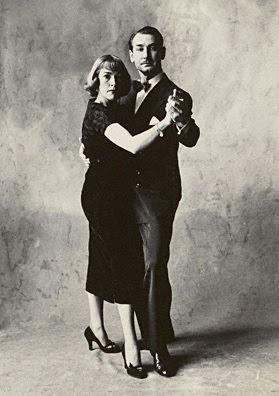 The desired effect is a sense of smoothness and rhythmic grace between the partners, and not a flashy, theatrical display for the spectators. The Foxtrot, as it was danced in the ballrooms and nightclubs of the 20s and 30s, was not about showing off.
The desired effect is a sense of smoothness and rhythmic grace between the partners, and not a flashy, theatrical display for the spectators. The Foxtrot, as it was danced in the ballrooms and nightclubs of the 20s and 30s, was not about showing off.
I will let a man of the era describe it (Dancing Made Easy, Coll, 1922)
"Fox Trot is hardly a descriptive title, as indeed this dance, which seems to hold the fundamental principles of modern dances, is most unlike a trot. Indeed it is a smooth, easy dance and the most dignified of modern dances."
And woman from 1930 (Modern Ballroom Dancing, Ray)
"The popular movement is the Walk-Step. There are slow walk steps and fast walk-steps. The fast ones are twice as fast as the slow ones. Both are used throughout the dance.
There are four beats to a measure of Fox Trot music. Count 1,2,3,4. Simply step forward with your left foot (count 1,2). Then step forward with your right foot (count 3, 4), The steps should be long and gliding."
And again from Coll in 1922
"In taking the walking steps between variations, as described. Let it be a long and slightly "springy" step, of, say, the length of your foot, with a reaching sort of movement. You will find that this gives a dancing character to the step at once. Step, touching the ball of the foot first, resting naturally on the heel."
There are a lot of variations in how a Foxtrot can be played. Foxtrots can be so different from one another that they share nothing but 4-4 time. They can be slow, moderate, fast or insane, and you as the dancer are free to chose the step that works for you.
You can step on every beat (referred to as a "quick" or "fast" step) or you can step on every other beat (referred to as a "slow" step: 1 - 3 - 5 - 7). You can also mix it up, stepping on alternate beats for a few steps and then on every beat for a few more. The familiar "slow, slow, quick, quick" is a way of expressing this mixed approach. Each piece of music will suggest its own interpretation. Often the band will accent the first beat in any pair, giving you a strong suggestion that maybe you might want to step on that beat, or sometimes the beats will have equal emphasis or sometimes there will be no "rhythm section" and you will just pick out the beat from the melody.
In the end, just feel the music and let your feet tell you what to do. Anything that works for you, and which your partner can follow, is fine and it is entirely normal if the couple next to you is doing something completely different.
All that matters is what feels right for you and your partner. I would suggest, when you hear the music, start rocking side to side to the music. That is the natural beat as you hear it, and each rock would be a step. This rocking will also cue your partner as to what to expect when you start stepping out. American men generally step first with the left (women with the right). Europeans could start with either foot.
"There is no accepted or rigid rule-that is why each dancer seems to be indulging in different steps. They are dancing the Fox Trot but are varying it and adding their own expression. As you become expert you may endeavor to do this too; as you go on you will find that your personality will enter greatly into your dancing, and it is proper that it should."
Dancing Made Easy, 1922
Practical Exercise
1. Without a partner, put on a moderate tempo Foxtrot like Billie Holiday's "Carelessly" and listen to the beat. Then let your body sway left to right (for men) or right to left (for women) to the beat. That is the beat as you hear it. That will be your step. With that tune (as with many others), there's a strong emphasis on the first beat in the pair, that's the best choice for your step and that will put you in "slow" time.
2. Still without a partner, walk counterclockwise ("Line of Direction") around the room to the music, stepping lightly on the balls of your feet with a step that has a slightly springy feel. While walking, keep your gentle body sway. Take small steps. You always sway in the direction of the active foot. Sway left, step left - sway right, step right. The sway will be a cue to your partner what foot you are on.
3. Take you partner in the close hold of the Jazz Age, and sway together to the music. Lead starts on his left, Follow on her right.
4. The Lead then starts to move - step first with your left foot backward (it's a good practice to always make your first step away from your partner, it lessens the element of surprise) and follow with your right. While you're stepping try to keep your gentle body sway. You can then step forward (backing her) for as many steps as you like. Take small steps.
5. Gently turn your partner in the "natural" direction (clockwise) by stepping forward with your left foot and back with your right.
6. (After checking for obstacles) walk backwards for a few steps, then turn her again and then back her for a few steps. Repeat.
7. Gently turn your partner in the "reverse" direction (counterclockwise) by stepping back with your left and carefully forward with your right (don't step on her toes).
If you are comfortable with this, you are doing pretty much what about 60% of the dancers in old films are doing. You're ready to get out on the floor if you like. If you think there should be more to dancing, read on.
Some Suggested Variations
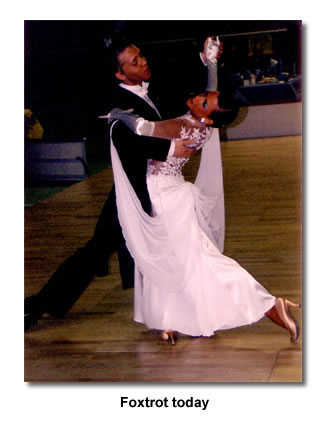
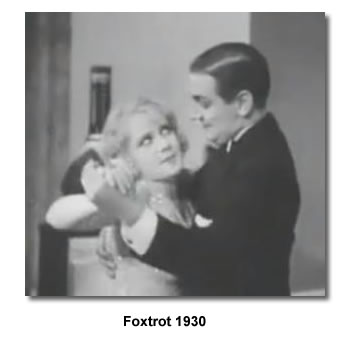 The directions are given to the gentleman. The lady will mirror him. This is not a routine. These variations can be done in any combination and repeated as many or as few times as you like.
The directions are given to the gentleman. The lady will mirror him. This is not a routine. These variations can be done in any combination and repeated as many or as few times as you like.
- A balance step: man takes 2 short steps back (left, right) then then forward (left, right). This can be done straight, as a slow rotation, or by shading left and right as a sideways traveling step. It can also be done with the man stepping forward first. It is an excellent way to start the dance and, if the floor is crowded, can be the foundation of your dance. It can be used as a traveling step with the man backing the woman when he's advancing and then pivoting to continue in the line of direction with the man backing. Men danced backwards a lot in the Foxtrot era.
- Walk left-right-left and then bring your right up together with your left on count four giving a sense of 1-2-3-pause. Step out with your left and repeat.
- "Promenade" with both partners facing line of travel (facing man's left hand) and walking forward side by side. Do it as long as you like. It's very useful for maneuvering for position on a crowded floor
- While backing the lady or promenading, take two steps and on step three, turn to face your partner while taking a side step with your left and then bring the right up beside it (View illustration)
- Partners facing each other, step to the left, bring up right foot with a sliding step. Repeat. The effect is a continuous slide with the man's left hand in the lead. There is a slight rocking motion with each step and this step can be continued as long as you like.
- The Two-Step: this step, which is a descendant of the 19th Century Polka step, was a VERY popular foundation step for a lot of dancers. It can be done in either slow or quick time, and can be tuned to fit many different musical moods. We'll do this one in Slow Time. Lead starting on this left: step left, bring up the right, step left and taking two beats to do it, change direction and step right, bring up the left, step right....It is often described as "Step-together-step-AAAAND-step-together-step".
- This one is courtesy of Arthur Murray in 1938. He called it (for reasons I can't even guess) the "Collegiate Swing". Take two walking steps in "slow time" (1 step for every two beats) and then two side steps (step left, bring right up beside the left) done in "quick time" (1 step per beat)- thus "slow-slow-quick-quick". Note: this step is often regarded, in our present day, as THE basic Foxtrot step. Back in the Jazz Age, it was just one of many variations, with no more or less validity than any other.
Nothing gives a better sense of how the dance was danced than seeing people of the era dance it. The first is a general overview of the Jazz Age Fox Trot, to include the more up-tempo styles covered in part 2. The second is a 1930 Dutch instructional film (slightly edited). Next is a great pastiche of Foxtrot scenes from various films of the '20s and '30s. Note the dynamic of counterclockwise movement and the very simple variations the dancers work into their patterns (mostly turns and side steps). The next ones provide more details with some interesting variations.
Here's one from the 1930 film "Love in the Rough" with a nice sense of many basic Foxtrot variations
This one, from the 1942 film "Listen to Britain", is a snapshot of the sort of dancing you would see in a British public ballroom in the '30s and '40s. Note the wide variety of skill levels (the better dancers seem to gravitate to the middle of the room), the fact that they are Foxtrotting to the Beer Barrel Polka, their strict adherence to line of direction and the chap in the middle, in formal wear, who seems to be there to keep traffic moving.
Here's a wonderful mix of styles in a dance pavilion, ranging from cool sophisticates in evening clothes to exuberant Jazz Babies - from the 1932 film "Hot Saturday".
This one, filmed at the 1939 New York World's Fair, shows a mostly young and mostly female, but racially mixed bunch of folks Swing dancing and Foxtrotting in the open air. I include it because it has a lot of interesting stylistic details in the Foxtrot bits, but it also gives a sense of how the Foxtrot was an integral part of the Swing dance world (something that seems to have been mostly forgotten today)
And here's a wonderful snapshot of Glenn Miller playing "In the Mood" in a swanky nightclub for an audience that would not Jitterbug. Here is how to Fox Trot to a classic swing piece.
A few keywords for the benefit of various search engines: Roaring '20s, Depression era, Foxtrot, Fox Trot, ballroom dances, ball room dance, smooth dancing

